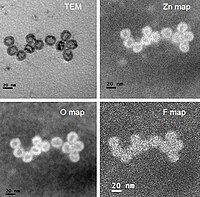
Photo from wikipedia
In this paper, we systematically investigated the electronic, optical, and transport properties of CdTe and ZnTe nanostructures before and after adsorption with benzyl viologen (BV) and tetrafluoro-tetracyanoquinodimethane (F4-TCNQ) organic molecules… Click to show full abstract
In this paper, we systematically investigated the electronic, optical, and transport properties of CdTe and ZnTe nanostructures before and after adsorption with benzyl viologen (BV) and tetrafluoro-tetracyanoquinodimethane (F4-TCNQ) organic molecules based on the first principles calculation. First, the band gaps of CdTe and ZnTe nanostructures obviously decrease after BV and F4-TCNQ adsorptions. Interestingly, the electronic property calculation shows that BV and F4-TCNQ can donate/accept electrons to/from the surface of CdTe and ZnTe nanostructures, leading to an effective n-/p-type doping, respectively. Second, the optical absorption in a broad spectral range (from visible to near-infrared) of CdTe and ZnTe is significantly improved by adsorption of BV and F4-TCNQ molecules, offering great opportunities for the use of CdTe and ZnTe nanostructures in renewable energy fields. Lastly, the electrical transfer characteristics on CdTe and ZnTe nanostructure-based field-effect transistors clearly showed that the conduction of the nanostructures can be rationally tuned into n- and p-type conductivity with BV and F4-TCNQ adsorptions, respectively. Our work clearly demonstrates that the electronic, optical, and transport properties of CdTe and ZnTe nanostructures are effectively modulated by adsorption of BV and F4-TCNQ, which can be used to construct high-performance electronic and optoelectronic devices.
Journal Title: ACS Omega
Year Published: 2020
Link to full text (if available)
Share on Social Media: Sign Up to like & get
recommendations!